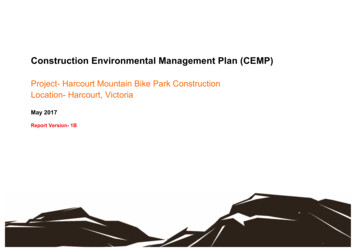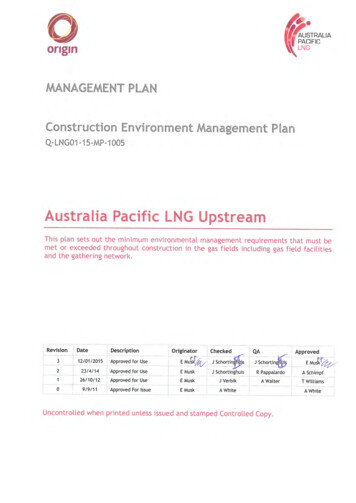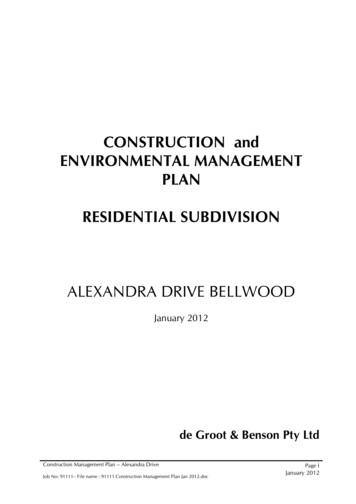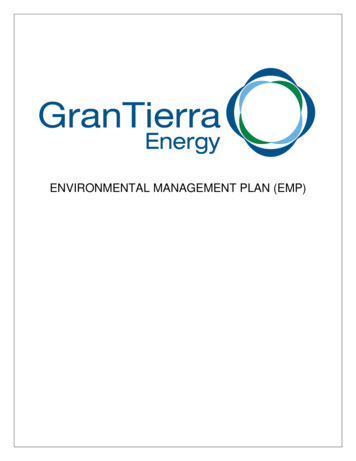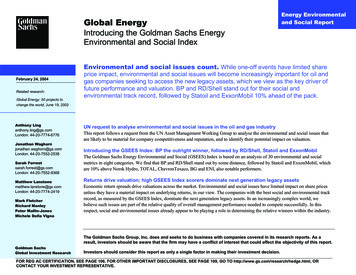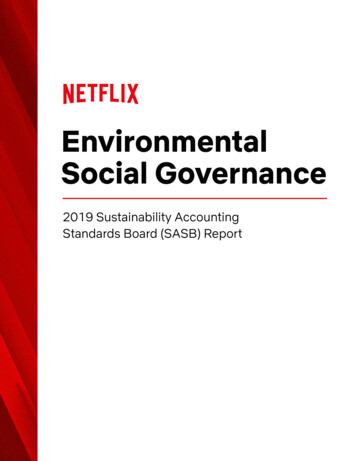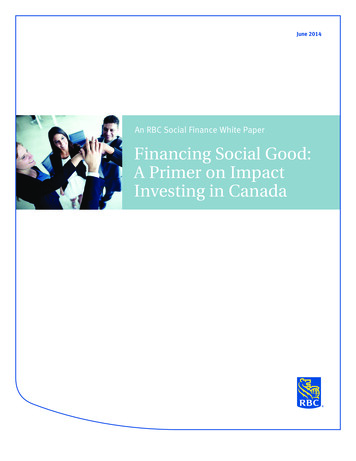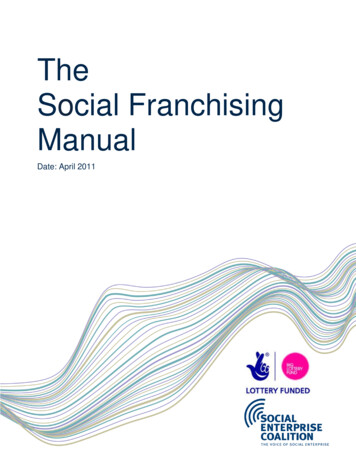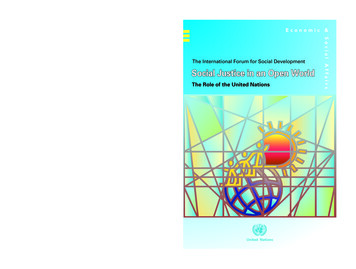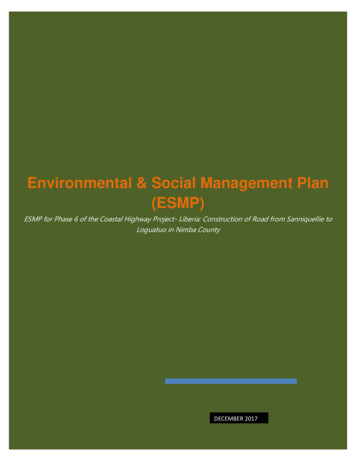
Transcription
Prepared by: Tri-Star Collaborative Environmental & Social Management Plan(ESMP)ESMP for Phase 6 of the Coastal Highway Project- Liberia: Construction of Road from Sanniquellie toLoguatuo in Nimba County0DECEMBER 2017
Prepared by: Tri-Star Collaborative GENERAL INFORMATIONProject Title:COASTAL HIGHWAY PROJECT PHASE 6 - LIBERIA:CONSTRUCTION OF ROAD FROM SANNIQUELLIE TOLOGUATUO IN NIMBA CountyProject Number:Country:LIBERIADepartment:MINISTRY OF PUBLIC WORKSDivision:Project Category:Starting date of implementation:Project completion date:Date of operation :Period covered by the plan:1
Prepared by: Tri-Star Collaborative LIST OF C2African Development BankAIC ProgettiCountry Strategy PaperEnvironmental Protection AgencyEuropean Principles for the EnvironmentEnvironmental Protection and Management LawEnvironmental and Social Assessment ProcedureEnvironmental and Social Impact AssessmentEnvironmental and Social Management PlanEuropean UnionFood and Agriculture Policy StrategyForestry Development AuthorityFauna and Flora InternationalGovernment of LiberiaGrievance Redress CommitteeGrievance Redress MechanismIntegrated Environmental and Social Impact AssessmentInfrastructure Trust FundMinistry of Planning and Economic AffairsMinistry of Public WorksPerformance Standard 8Project Implementation UnitResettlement Action PlanRegional Member CountryRight of WayStrategic Environmental and Social AssessmentStrategy Impact AssessmentTristar Collaborative
Prepared by: Tri-Star Collaborative EXECUTIVE SUMMARYIntroductionAfter the war that ended in 2003, the Government of Liberia, with the assistance of the donorcommunity, developed in 2008 the first Poverty Reduction Strategy (PRS). The PRS defined thedevelopment programme of the government of Liberia. Since then, a new Poverty ReductionStrategy called The Agenda for Transformation, Steps toward Liberia RISING 2030, covering theperiod 2012-2017 has been developed and is now underway. Together with the wider economythe transport system was devastated by the long period of war. Value added by the transport andcommunication sector in Liberia fell by 69% between 1987 and 2005. However, following policyreforms introduced by the new government, Liberia has made substantial progress. TheNational/Regional Indicative Programme of the 10th EDF signed by the Government of Liberiaand the European Commission reflects the EC’s willingness to support the transport sector inLiberia. Within the framework of this Indicative Programme, it has been foreseen to allocatefunds for feasibility studies, detailed designs, optional procurement services and optionalsupervision of works, of which the Environmental and Social Impact Assessment for Phase 6 ofthe Coastal Highway project; stretching from Sanniquellie to LoguatuoObjectiveThe objective of the assignment was to prepare a detailed ESMP to address the anticipated negativeenvironmental and social impacts of the project.ScopeThe scope of services undertaken by the Consultant included the preparation of the ESMP whosepurpose was to define and reach an agreement with project sponsors concerning the following: Beneficial and Adverse Impacts Mitigation and enhancement programs Monitoring programs Consultations Complementary initiatives Responsibilities and institutional arrangements Estimated costs Implementation schedules and Reporting3
Prepared by: Tri-Star Collaborative Legislative FrameworkChapter Two of this project report outlines several legislative issues that were considered duringthe exercise. This is to ensure that the proposed project complies with the relevant legislative andplanning requirements of Liberia. They generally comprise of legislations that encompass lawsrelating to environment, agriculture, water, public health and land.The project in question generally conforms to the legal requirements outlined in Chapter Two andsubject to the ESMP proposed in Chapter Five of this report.ContextAs indicated in the introduction section, This project falls under the “Coastal Highway Project”which comprises the construction of a number of roads across Liberia, funded by the AfricanEuropean Union and the Development Bank (AfDB). Specifically, this component is the phase 6of the Coastal High Project and involves the reconstruction of the road from Sanniquellie toLoguatuo in Nimba County. This chapter of the ESMP document looks at the location andtechnical description of the proposed project and briefly describes project activities and majorenvironmental and social components that will likely be affected positively or negatively by theproject.MethodologyThe consultant adopted a participatory methodology during the study. Several consultativemeetings were conducted with MPW, the communities and other stakeholders. The consultantfurther reviewed various legal issues relevant to the exercise. The existing Environmental ImpactAssessment Report was reviewed in detail by the consultant. The following sections provide abrief of the key findings.Beneficial and Adverse ImpactsPositive ImpactsThe major positive impacts are related to job opportunities. The direct and indirect jobopportunities that will be provided by the project can be considered as a positive aspect. The localpeople will be directly employed to work at the construction sites. Some individuals may gainskills that can be applied in other road construction projects.The benefits of the project include easy access to other communities and major towns and citiesas well as to schools and public services are evident. Potential beneficiary enterprises affected byand contributing to regional socio-economic transformation will be small industries like saw millsand joineries, grain mills and other agricultural processing, trade and storage businesses. As aconsequence, the quality of life and extent of economic opportunity will be transformed.4
Prepared by: Tri-Star Collaborative On the gender side, women should benefit from opportunities to work on the project as a result ofproject gender policy. Such income and opportunities for trading and provision of services tosalaried project workers will help women to start small businesses.Adverse ImpactsRoad construction projects can be expected to have direct and indirect impacts onvillages/settlements where the proposed route will pass. The potential for negative direct impactsmight be in any social and cultural interaction between the contractor’s workers and localpopulations. There may also be minor effects on agriculture, if there would be a restriction onland use in the right of way, and, in any involuntary resettlement requirement. Issues addressed inthe ESMP include negative impacts with respect to the biophysical environment; the main aspectsanalyzed are the impacts of the project on water resources, tree cutting, local land degradation andsoil erosion, slope stability, aesthetics and visual impact and ecological issues.Potential Socio - Economic ImpactsAlong the road and within the right of way there were housing units, fences of different types.However, these will need to be compensated for, hence there will be the need for a ResettlementAction Plan (RAP) for this project.Also, farmlands and plantations along the wayleave owned by different farmers may be affectedby the project. The project intends to mitigate this by minimizing land takes in areas of ROWwhere there are farms and plantations.Furthermore, other important potential socio-economic impacts which need to be managedinclude: health and safety threats, possible impact of immigrant workers, together with impact onaesthetic values.Mitigation Measures and Complementary InitiativesNo impacts are anticipated if planning and management for the project follows detailedframeworks developed for the project. The road follows the old corridors and therefore willminimize compensation and resettlement requirements.Environmental and Social Monitoring ProgrammeThe overall objective of environmental and social monitoring is to ensure that mitigationmeasures are implemented and that they are effective. Environmental and social monitoring willalso enable response to new and developing issues of concern. The activities and indicators thathave been recommended for monitoring are presented in the ESMP. Environmental monitoringwill be carried out to ensure that all construction activities comply and adhere to environmentalprovisions and standard specifications, so that all mitigation measures are implemented.ConsultationsPublic consultations have been held with local population in the project area by AIC/TSC andMPW while preparing the ESMP. Furthermore, the standard procedures will be followed fordisclosure in line with guidelines of the EPA.5
Prepared by: Tri-Star Collaborative Responsibilities and Institutional ArrangementsMPW will ensure implementation of the project ESMP with the support of its environmental staff.Contractors will be held to account for implementation of their responsibilities in the Project ManagementMatrix. The institutional arrangements for implementation of the ESMP under the project include thefollowing: EPA MPW Environmental steering committee Supervision consultant (Lead environmentalist) Contractor Project FinanciersEstimated costsThe estimated cost of implementing the ESMP was a total of Eight Hundred and Ninety SevenThousand, Seven Hundred and Ten United States Dollars (USD 897,710). Table 7 details the costitems of Capacity Building and institutional strengthening while Table 9 provides the costbreakdown for Mitigation Activities as well as Monitoring Measures.Implementation Schedule and ReportingThe activities related to environmental and social management and monitoring have to beintegrated in the overall construction schedule. Most of the environmental management actionsare standard or "good housekeeping" measures applicable to construction projects. These have tobe observed throughout the construction activities and are shown as an overall activity. The keyelements of the implementation schedule are presented in Table 8 of this ESMP.ConclusionMPW recognizes that it has a role to play and a responsibility in protecting and enhancing theenvironment in which the project is to be deployed to meet the needs of the communities withoutcompromising the integrity of the environment and a major disruption of the socioeconomic setupof project affected areas. This Social and Environmental Management Plan has thereforedescribed in detail the processes MPW will follow to maximize its compliance to statutoryrequirements as well as those of project sponsors and minimize the impacts of the project on thegeneral environment.6
Prepared by: Tri-Star Collaborative Table of ContentsGENERAL INFORMATION . 1LIST OF ACRONYMS . 2EXECUTIVE SUMMARY . 3Table of Contents . 7LIST OF TABLES . 91.0 INTRODUCTION . 102.0 OBJECTIVE OF THE ESMP . 122.1 Scope of the ESMP .122.2 POLICY, LEGAL AND ADMINISTRATIVE FRAMEWORK .122.2.1 Ministry of Public Works .132.2.2 Constitution of the Republic of Liberia .142.2.3 Components of legal framework .142.2. 4 The National Environmental Policy of Liberia .142.2.5 The National Transport Master Plan .162.2.6 Community Rights Law .162.2.7 Customary Law .172.2.8 AfDB’s Environmental Policy, Legal and Institutional Framework .172.2.9 EU’s Environmental Policy, Legal and Institutional Framework .192.2.10 International Standards and Best Practices .193.0 CONTEXT . 203.1 Project Location .203.2 Location of Nimba County .203.4 Anticipated Extent of Environmental and Social Impact .213.5 ESMP Approach .213.5.1 Methodology .217
Prepared by: Tri-Star Collaborative 3.5.1.1 Desk Review .213.5.1.2 Public Consultation Forum .224.0 BENEFICIAL AND ADVERSE IMPACTS . 244.1 Negative Impacts .244.1.1 Disruptions from Pre-Construction Activities: .244.1.2 Disruption during construction .244.1.3 Social Impacts .264.1.4 Operation Phase Negative Impacts .294.1.5 Decommissioning Phase Impacts .304.2 Positive Impacts of the Project: .315.0 ENAHNCEMENT AND MITIGATION PROGRAMME . 345.1 Mitigation of Impact on Local Population .345.1.1Contractors’ obligations and legal requirements .346.0 MONITORING PROGRAMME . 366.1 Internal Monitoring .376.1.1 External Monitoring and Evaluation .416.1.2 Monitoring Controls .447.0 CONSULTATIONS . 517.1 Construction and Operational Phase Consultations .517. 2 Stakeholder Engagement Plan .517.2.1 Establishment of Community Liaison Team.517.2.2 The Consultation Plan .527.3 Grievance Redress Mechanism .527.3.1Purpose of Grievance Redress Mechanism .527.3.2 Members of the Grievance Redress Committees (GRC) .527.3.3 Steps involved in the Grievance Redress Mechanism .538
Prepared by: Tri-Star Collaborative 8.0 COMPLIMENTARY INITIATIVES . 548.1 Gender Assessment .548.2 HIV/AIDS Component.559.0 RESPONSIBILITIES AND INSTITUTIONAL ARRANGEMENTS . 569.1 Capacity Building and Institutional Strengthening .58Capacity building for Contractor Personnel:.5810.0 ESTIMATED COSTS . 6010.1 Environmental and Social Management Plan Cost .6111.0 ESMP IMPLEMENTATION SCHEDULE . 6912.0 CONCLUSION . 69REFERENCES . 71APPENDICES . 72APENDIX A: Notice of Intent .72APPENDIX B: Letter of Introduction for Studies .73LIST OF TABLESTable 1: Project Route Within Nimba County .20Table 2: Ambient Air Quality Monitoring.38Table 3: WHO Drink
MPW will ensure implementation of the project ESMP with the support of its environmental staff. Contractors will be held to account for implementation of their responsibilities in the Project Management Matrix. The institutional arrangements for implementation of the ESMP under th
